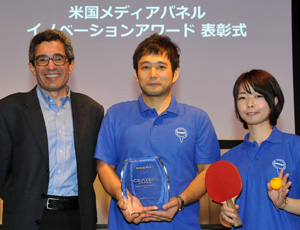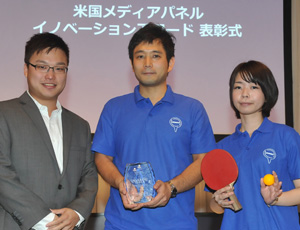CEATEC JAPAN 2014 Innovation Awards
"As Selected by U.S. Journalists”
Winners
Grand-Prix
Table Tennis Rallying Robot

- comments

Robots have captured the imagination of the technology industry. Google is working on driverless cars. Amazon is developing drones. Robotics is anticipated to grow to be a $20 billion industry by 2016.
Omron, which has long been a leader in automation and industrial machinery, is developing the core technology for the next generation of robotics. Currently, industrial robots are generally built to perform fixed, repetitive tasks. Omron’s Ping Pong Robot is a thought experiment: will it be possible to develop robots that can perform a variety of tasks in a changing environment? A robot that can adapt to circumstances could do the work of six or seven fixed function robots.
Creating such a robot, however, would also require advances in real time processing, sensing and mechanics.
To create its Ping Pong Playing robot, Omron leveraged technology from different disciplines. It is a work in progress, but the company is clearly off to a very good start.
Omron also, significantly, came up with a clever way to highlight its accomplishments. It was one of the most popular exhibits at the show. Industrial technology is often overshadowed by cell phones and other flashier products. Omron came up with a way to make people stop, listen and maybe start to think about technology advances that they may not fully experience for a few years.- Michael Kanellos
- Exhibit Information
- OMRON Corporation
-
Software
- comments

This is my fourth year at CEATEC JAPAN, but never have I imagined that I would get to play ping pong at this trade show – let alone playing against a robot! Just two days ago, I had the pleasure to experience OMRON Corporation’s ping pong robot, and while I was initially petrified by its enormous size, it quickly felt like I was playing against an actual human: The robot felt real, in the sense that it reacted very much like an average human player would. I didn’t even feel bad when I lost to the robot, because it was such a fascinating experience.
This is not possible without OMRON’s advanced software capabilities, which drove the analysis of the human player’s movement plus the tracking of the ball, in order to quickly predict the ball’s trajectory and speed, as well as returning the ball to the human in a friendly manner. With such vast computing power and quick mechanics, you can imagine the robot’s potential in factory automation: It’s not just about quickly and accurately completing tasks, but it’s also about quickly spotting and solving irregularities in production lines.- Richard Lai


